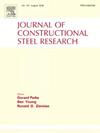基于LCF试验中弹性模量退化行为的疲劳寿命评估
IF 4
2区 工程技术
Q1 CONSTRUCTION & BUILDING TECHNOLOGY
引用次数: 0
摘要
本研究在极低周疲劳(ELCF)和低周疲劳(LCF)试验中考察了卸载过程中弹性模量的退化行为,旨在更深入地了解循环加载下结构钢的损伤进展。将总应变幅恒定的单轴拉压缩循环加载,范围从1%到9%,应用于两种类型的结构钢:490 N/mm2级钢表现出循环硬化,550 N/mm2级钢表现出循环软化。通过有限元分析探讨了试样几何形状变化对循环加载下卸载弹性模量的影响。试验结果表明,在LCF状态下,两种钢的卸载弹性模量保持相对恒定,直到由于致命的大裂纹扩展而突然退化。相比之下,在ELCF模式下,卸载弹性模量从第一个循环开始逐渐下降,主要是由于颈缩现象,通过有限元分析证实了这一点,随后在致命的大裂纹扩展时迅速下降。随着宏观裂纹的形核和扩展,卸载弹性模量和拉峰值应力(定义为在拉伸作用下每个循环的峰值应变处的应力)都急剧下降,反映了有效抵抗截面积的减小。因此,可以通过跟踪卸载弹性模量或拉伸峰值应力来评估疲劳寿命,直到快速大裂纹扩展开始的点。本文章由计算机程序翻译,如有差异,请以英文原文为准。

Fatigue life evaluation based on elastic modulus degradation behavior in LCF testing
This study examined the degradation behavior of the elastic modulus during unloading in both extremely low-cycle fatigue (ELCF) and low-cycle fatigue (LCF) tests, aiming to gain deeper insight into damage progression in structural steel under cyclic loading. Uniaxial tension–compression cyclic loading with constant total strain amplitudes, ranging from 1 % to 9 %, was applied to two types of structural steel: 490 N/mm2 grade steel that exhibited cyclic hardening and 550 N/mm2 grade steel that exhibited cyclic softening. Finite element analysis (FEA) was also conducted to explore the influence of changes in specimen geometry on the unloading elastic modulus under cyclic loading. The experimental results showed that for both steels, in the LCF regime, the unloading elastic modulus remains relatively constant until it suddenly degrades owing to fatal macrocrack propagation. Contrastingly, in the ELCF regime, the unloading elastic modulus gradually decreases from the first cycle, primarily owing to the necking phenomenon, as confirmed through FEA, followed by rapid degradation when a fatal macrocrack propagates. As the macrocrack nucleates and grows, both the unloading elastic modulus and tensile peak stress (defined as the stress at peak strain in each cycle under tension) decline sharply, reflecting the reduction in the effective resisting cross-sectional area. Thus, the fatigue life, up to the point where rapid macrocrack propagation begins, can be evaluated by tracking either the unloading elastic modulus or tensile peak stress.
求助全文
通过发布文献求助,成功后即可免费获取论文全文。
去求助
来源期刊

Journal of Constructional Steel Research
工程技术-工程:土木
CiteScore
7.90
自引率
19.50%
发文量
550
审稿时长
46 days
期刊介绍:
The Journal of Constructional Steel Research provides an international forum for the presentation and discussion of the latest developments in structural steel research and their applications. It is aimed not only at researchers but also at those likely to be most affected by research results, i.e. designers and fabricators. Original papers of a high standard dealing with all aspects of steel research including theoretical and experimental research on elements, assemblages, connection and material properties are considered for publication.
 求助内容:
求助内容: 应助结果提醒方式:
应助结果提醒方式:


